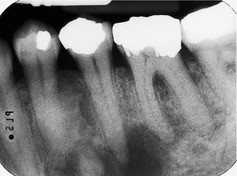Case• 62. A case of toothache
SUMMARY
A 36-year-old Nigerian lady presents in your practice for the first time, complaining of toothache.
History
Complaint
She complains of toothache associated with her lower left teeth and points somewhat imprecisely to the lower left quadrant.
History of complaint
The patient has been aware of intermittent pain at this site for several months. Initially the pain was short lived and brought on by hot and cold drinks but in the last few days the discomfort has become progressively worse. She is now suffering a fairly constant and very painful toothache which is no longer closely related to hot and cold stimuli.
Medical history
She is otherwise fit and well and no positive findings are revealed by the medical history.
Examination
Extraoral examination
She is a fit and well-looking African lady. The submandibular lymph nodes are not palpable. There is no detectable soft tissue swelling and the temporomandibular joints appear normal.
Intraoral examination
The lower left second premolar and first and second permanent molars are heavily restored. There is only a small restoration in the first premolar. Several other teeth contain smaller restorations. The surrounding oral mucosa appears normal and there is no bony enlargement or swelling. No tenderness is elicited on palpation of the lingual or buccal sulcus adjacent to the teeth and the contour of the tissues here is normal.
▪ How do you interpret the history and examination so far?
The clear history of toothache (which is normally correctly identified by patients) and the large restorations suggest that one or more teeth may be the cause of the pain, probably as a result of caries or complications of restoration. The pain is poorly localized, severe, feels like toothache and has been exacerbated by hot and cold, almost certainly indicating pulpitis. The recent onset of pain unrelated to hot and cold suggests late or irreversible pulpitis but that the causative pulp remains partially vital. The history does not suggest spread of infection or inflammation to the periodontal ligament, which is normally associated with pain on biting and accurate localization of the causative tooth by the patient.
▪ What simple additional examinations would you perform and why?
All the teeth in the lower left quadrant distal to, and including, the canine should be percussed. The same teeth should be tested for vitality, together with their equivalent lower right teeth for comparison (provided there are no clinical features such as caries or restorations suggesting that these also have compromised vitality).
When this is done, it is found that no teeth are particularly tender to percussion. Both the second premolar and first molar may be slightly tender (the patient is unclear) but neither gives a dull percussive note. The second premolar is vital. The first molar is slightly hypersensitive, both by electric pulp testing and application of a cold stimulus (ethyl chloride), neither test causing acute pain.
Investigations
▪ What investigation would you now undertake and why?
An intraoral periapical radiograph of the lower left premolars and first molar should be taken. The examination so far indicates that the first molar is the most likely cause of the pain. However, the patient is vague as to whether the second premolar is tender to percussion and it contains a large restoration. There may be two causes for the pain.
A radiograph cannot provide direct evidence of vitality. However it will give information on possible causes of loss of vitality, particularly caries and inadequate restorations, as well as revealing previous attempted root canal treatment and periapical granuloma or infection (provided there has been sufficient time for apical bone loss to develop). A radiograph will also be required in the event that either extraction or root canal treatment is necessary.
▪ The periapical radiograph is shown inFigure 62.1. What do you see?
Stay updated, free dental videos. Join our Telegram channel

VIDEdental - Online dental courses



